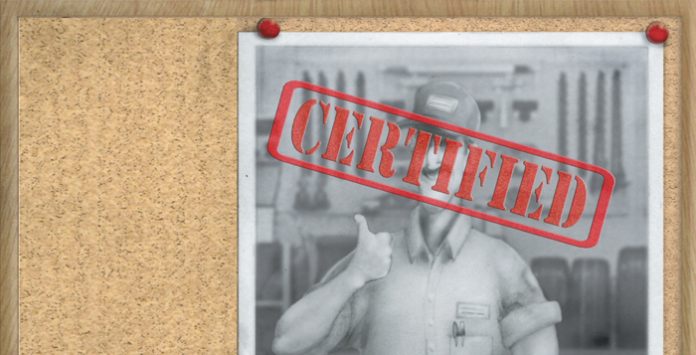What should shop-certification programs require? And are they a good investment?
By John Joswick
Collision shop-certification programs tend to take one of two types of approaches to designating a business as meeting the specifications. One focuses on what might be called “inputs”: Does the shop have the trained technicians, equipment and facility to do the work properly? The other approach includes also looking at “outputs”: performing regular, hands-on audits of completed or in-progress repairs to ensure the shop is doing “certified-quality” work.
General Motors’ current shop-certification program focused solely on the Cadillac CT6, for example, has been primarily an “inputs” program. But GM’s John Eck at industry events in the past year has indicated that the automaker may be moving toward a broader collision shop-certification program for more of its vehicles, and that program may well have more than just requirements for training and equipment.
“How do we ensure that the welding is being done by that person [at the certified shop] who is trained in welding?” Eck said at the Society of Collision Repair Specialists “Repairer Roundtable” held in Pittsburgh, Pa., this past spring. “A shop may be certified. That’s one thing. But making sure that the trained personnel are actually doing the welding or blueprinting or whatever is another.”
Eck said he’d like to see a program that includes more ongoing measurements of certified shops.
“How do we go to the next level and measure some of the metrics that are important to the OEMs,” Eck said, comparing it to the metrics insurance companies use to measure their direct-repair shops. “Now the OEMs are saying: With certification, we need the right metrics in place as well.”
He said automakers see the shop-certification programs as a key part of helping protect their brands.
“We want to make sure safety is maintained going out the door,” Eck said. “When we look at what’s going on in the marketplace, it causes OEMs concern. And that’s why you’re seeing some of the position statements you’re seeing, and you’ll probably see changes in the repair procedures, and certainly more of them.”
NSF International, the Michigan-based company that certifies non-OEM parts, also has a shop certification program. NSF’s Bob Frayer said the ongoing audits of repaired vehicles that the program requires is part of what he sees as setting the program apart.
“This is where our auditors actually are looking over the shoulder of the person doing the repair, and we’re actually going out and checking cars that have been repaired to make sure they were repaired properly,” Frayer said.
It’s similar to NSF’s parts certification, he said, which checks some of the actual parts being made, not just deciding a factory has the equipment and ability to make parts that are comparable to OEM.
“In our opinion, looking at the back-end is certainly just as critical if not more critical than looking at the front-end,” Frayer said of the shop certification program. “You can have the right equipment and training, but are you doing the repair properly? In my opinion, it would be sort of like certifying a manufacturer by saying, ‘Yeah, they have the right equipment and are using the right material, so you don’t have to worry about the parts they are making.’ Yes, we still have to worry about the parts they are making. They still have to use the equipment properly, and they still have to be able to apply the training. So the same thing applies to shops. You can’t just assume because they have the right equipment and training they are going to be repairing cars properly.”
On the other hand, even an auditing program doesn’t ensure that every car in a certified shop is being repaired right. That’s why Scott Biggs of Assured Performance, which administers collision shop-certification programs for a number of automakers, said his company’s program focuses primarily on certifying that shops have the tools, training and facility to repair cars correctly.
“From our standpoint, we’re not warrantying the repair, not in any way shape or form,” he said. “That still belongs to the shop. That’s their liability. We all know that any technician in any shop, no matter how well it’s tooled and equipped, can mess up a car. But if you don’t have the right tools, equipment, training and facility in the first place, you can’t ever fix any of them right. So you have to start with the foundation.”
He said the certification programs have a requirement that shops follow OEM repair procedures, and his company offers an app designed to assist technicians in documenting they have done so.
Considering return-on-investment
It’s generally not an inexpensive endeavor to qualify for shop certification. So are shops that do finding it a worthwhile investment? Certified shops generally say they find it a good way to differentiate and market themselves. Some automakers limit the sale of certain structural replacement parts to certified shops only, giving another advantage for those shops.
But shops taking on multiple certifications say that each comes with its own set of facility, equipment and training requirements. Shops have to consider if they will see a return — through a higher labor rate or new customers — on the money spent to meet the mandates of multiple programs when each may require, for example, a different brand of welder or rivet gun.
One shop owner, for example, estimates he spent about $70,000 on a welder, curtains and measuring jigs to qualify for one automaker’s shop certification, and he doesn’t seeing it paying off as yet. That automaker doesn’t limit the sale of any structural parts to non-certified shops, he said, so he feels he spent a lot of money for certification when that automaker’s vehicles are being fixed — perhaps not correctly — at other non-certified shops in his market.
Another shop owner said he sees the availability of OEM training as one of the biggest benefits of the shop-certification programs, but said that comes with added costs shops may not initially consider. Each time he sends a technician to another state for the training the automaker requires, he said for example, he is also paying that technician’s salary and travel expenses — while not having that tech working on vehicles in his shop for two weeks. He calculates that translates into $15,000 a week for his shop.
Barry Dorn of Dorn’s Body & Paint in Mechanicsville, Va., said the training costs for shop certifications also go up if a technician fails to pass the welding or other requirements automakers require. That’s why he chose to install a complete welding station in his shop that closely matches that of the OEM training facility where he sends technicians.
“So when we walk in [to the OEM facility], it’s familiar space,” Dorn said. “It looks the same. The equipment is the same. The way we clamp is the same. So as we take the test, it just feels the same. Honestly, positioning — how you lean up against something, how you rest your hand — all of this is part of the process and determines whether you are going to pass or fail. You need to have every advantage you can in order to pass.”
Dorn also brings in an industry trainer to work with his newer technicians welding, riveting and bonding well before they take the OEM training.
David Ludwig of Prestige Auto Body In Manchester, N.H., appreciates that Mercedes-Benz limits the sales of some structural parts to shops like his with Mercedes certification. But he couldn’t justify spending the $8,000 it would require to send a technician to Texas for Mercedes welding recertification every six months, so he chose a Tier II certification with the automaker.
He also is among those concerned about the expense of buying seemingly duplicative equipment to meet different automakers’ requirements. He said one $16,000 rivet gun he purchased should be considered capable of handling any automaker’s riveting requirements, but instead he’s had to buy others to qualify for other programs.
Most view them as a positive
Representatives of the automakers say they are not unsympathetic to the costs that specific equipment requirements can add to shops seeking multiple OEM certifications. Some automakers say that’s why they try to synch up their requirements to those of other automakers, or provide a specification-only list of equipment, allowing the shop to choose whatever tools meets those requirements.
But other automakers say they can’t test every brand and model of equipment to ensure they will perform as needed on their vehicles, so they have to specify the tools and equipment they have validated, and that are available in whatever countries in which their vehicles are sold.
And while certified shops may grumble about some of the costs involved, most remain cautiously upbeat about recouping their investment in certification. An industry survey last fall found that most collision repairers are satisfied — albeit somewhat tepidly — about the prospects for a return on their investment in OEM aluminum repair certification.
Of 244 aluminum-certified shops who responded to the question on a “Who Pays for What?” survey (http://www.CrashNetwork.com/collisionadvice), 13 percent said they felt “great” about what they see as “clearly a smart investment.” At the other end of the spectrum, four percent said they wished they hadn’t bothered, “at least when we did.”
The bulk of respondents chose responses somewhere in between. One in four, for example, said they were feeling “okay” about OEM aluminum certification but had some “concern about recouping the investment.” Another 15 percent said they were “starting to see some return.” And the largest group of respondents, 44 percent, said they “believe it will eventually pay for itself.”
That seems to jibe with anecdotal interviews with owners of certified collision shops.
“I honestly think it will pay off in the long-run, even if maybe not in the short-run,” the shop owner who expressed frustration with one automaker’s program said.
Ludwig said although he’d prefer a faster rate of return on his investment, he’s still bullish on OEM certifications.
“I still strongly believe it’s the wave of the future,” he said.
Biggs said there’s also another way to look at the expense of the certification programs.
“What’s the cost of not complying,” he said. “You can remove certification, but doesn’t every shop still need to buy the tools and equipment and have the training and facility modifications to properly repair the car? So the small amount for the certification itself, no matter whose it is, is a drop in the bucket compared to the investment in equipment and all the rest. The equipment costs you’re going to have to incur anyway if you’re going to safely repair a vehicle.” •
John Yoswick, a freelance writer based in Portland, Ore., who has been writing about the automotive industry since 1988, is also the editor of the weekly CRASH Network (www.CrashNetwork.com). He can be contacted at john@CrashNetwork.com.



